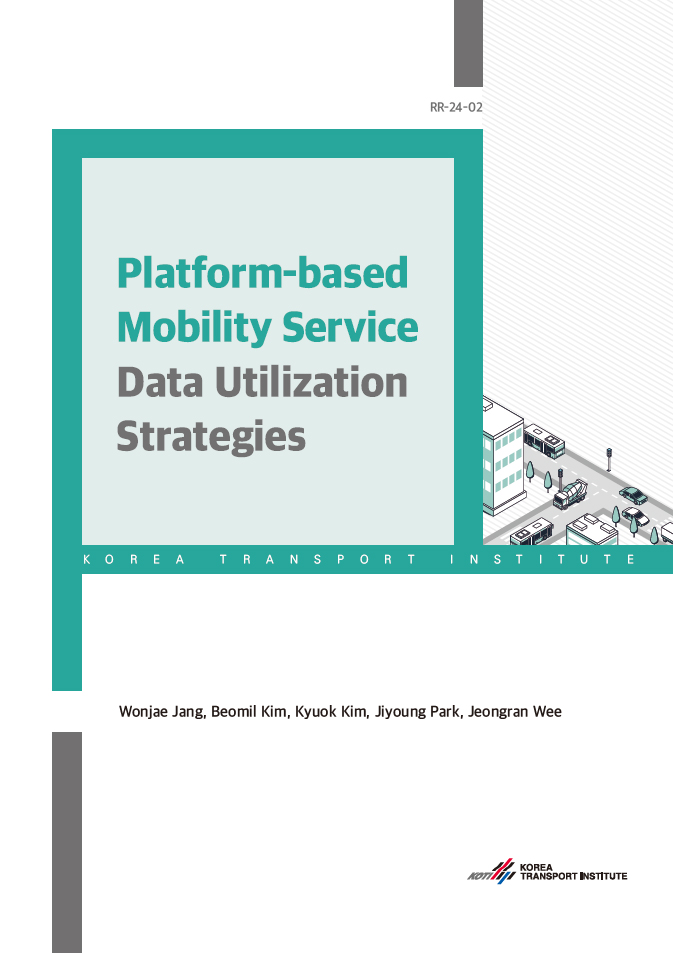Basic Report

RESEARCH
KOTI - Korea Transport institute
(RR-24-02) Platform-based Mobility Service Data Utilization Strategies
- Date
July 01 2025
- Authors
Wonjae Jang, Beomil Kim, Kyuok Kim, Jiyoung Park, Jeongran Wee
- Page(s)
15 page(s)

1. Introduction
With the convergence of advanced technologies such as information and communication technology (ICT) and artificial intelligence (AI) in the field of transportation, the traditional transportation industry is rapidly transforming into a platform-based mobility industry. Recently, a new paradigm in mobility has emerged, known as CASE (Connected, Autonomous, Shared, and Electric), which is leading to an explosive increase in data volume and an enhanced qualitative value of data utilization.
By using not only private sector data but also public mobility data, it becomes possible to ensure the public nature of platform mobility services and contribute to the growth of related industries. However, unlike traditional transportation data, platform-based mobility service data is primarily generated by individual private companies. There are challenges in securing and using such data due to the lack of specific legal provisions, and regulatory constraints related to personal data protection also limit external data sharing and utilization. Additionally, private companies are often reluctant to share data.
This study aims to explore ways to efficiently use high-value mobility data in both public and private sectors and propose improvements to the legal and institutional frameworks to support this. The study focuses on key platform mobility services such as ride-sharing services, connected vehicles, and autonomous vehicles, reviews relevant case studies, identifies new public and private sector use cases, and presents suggestions for legal reforms and cooperation frameworks for broader data utilization.
With the convergence of advanced technologies such as information and communication technology (ICT) and artificial intelligence (AI) in the field of transportation, the traditional transportation industry is rapidly transforming into a platform-based mobility industry. Recently, a new paradigm in mobility has emerged, known as CASE (Connected, Autonomous, Shared, and Electric), which is leading to an explosive increase in data volume and an enhanced qualitative value of data utilization.
By using not only private sector data but also public mobility data, it becomes possible to ensure the public nature of platform mobility services and contribute to the growth of related industries. However, unlike traditional transportation data, platform-based mobility service data is primarily generated by individual private companies. There are challenges in securing and using such data due to the lack of specific legal provisions, and regulatory constraints related to personal data protection also limit external data sharing and utilization. Additionally, private companies are often reluctant to share data.
This study aims to explore ways to efficiently use high-value mobility data in both public and private sectors and propose improvements to the legal and institutional frameworks to support this. The study focuses on key platform mobility services such as ride-sharing services, connected vehicles, and autonomous vehicles, reviews relevant case studies, identifies new public and private sector use cases, and presents suggestions for legal reforms and cooperation frameworks for broader data utilization.
[ Contents ]
1. Introduction
2. Review of Platform Data and Service Status
2-A. Concept of Platform-Based Mobility Services
2-B. Structure and Characteristics of Mobility Data
2-C. Current Status of Domestic and International Data Platforms
2-D. Implications
3. Case Studies of Data Development and Utilization
3-A. Shared Mobility Services
3-B. Connected Vehicles
3-C. Autonomous Vehicles
3-D. Issues and Improvement Directions
4. Strategies for Expanding Data Sharing and Utilization
4-A. Directions for Data Sharing and Utilization
4-B. Public Sector Data Utilization Strategies
4-C. Private Sector Data Utilization Strategies
5. Legal and Institutional Improvements for Expanding Data Sharing and Utilization
6. Conclusion and Policy Recommendations
1. Introduction
2. Review of Platform Data and Service Status
2-A. Concept of Platform-Based Mobility Services
2-B. Structure and Characteristics of Mobility Data
2-C. Current Status of Domestic and International Data Platforms
2-D. Implications
3. Case Studies of Data Development and Utilization
3-A. Shared Mobility Services
3-B. Connected Vehicles
3-C. Autonomous Vehicles
3-D. Issues and Improvement Directions
4. Strategies for Expanding Data Sharing and Utilization
4-A. Directions for Data Sharing and Utilization
4-B. Public Sector Data Utilization Strategies
4-C. Private Sector Data Utilization Strategies
5. Legal and Institutional Improvements for Expanding Data Sharing and Utilization
6. Conclusion and Policy Recommendations